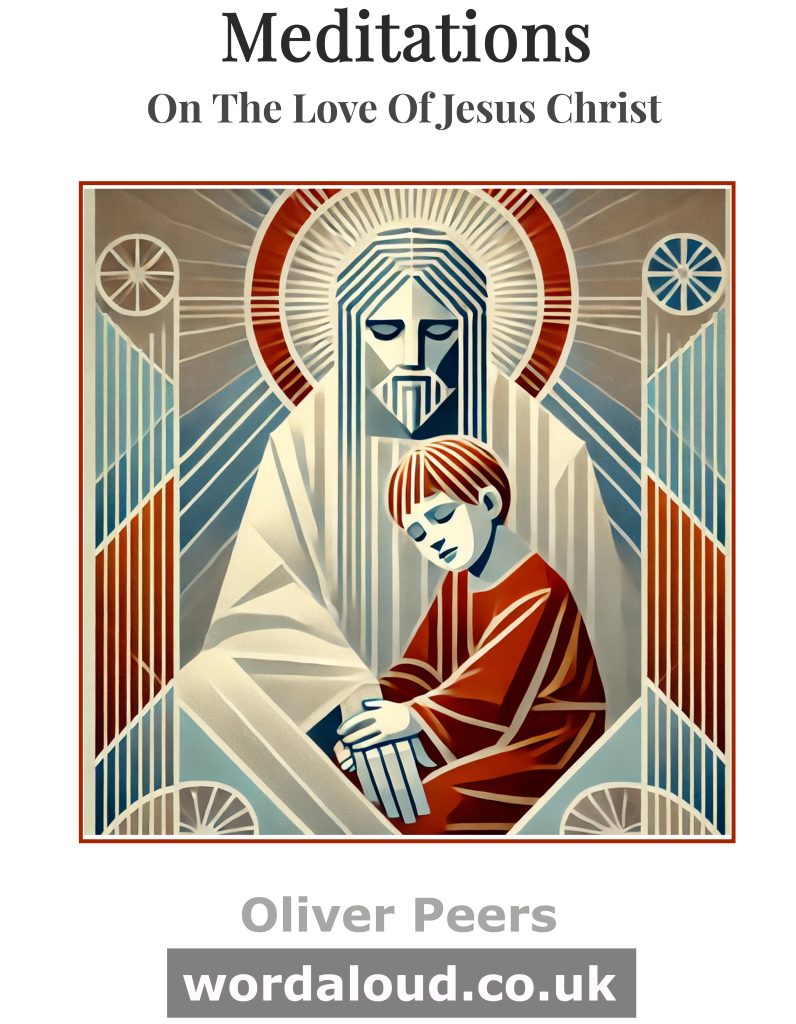Christian Art | Boy At Prayer With Jesus
Office Of Readings | Eastertide Week 3, Friday | A Reading From The Sermons Of Saint Ephraem | Jesus Christ’s Cross | Salvation Of The Human Race
‘Christ’s cross, the salvation of the human race.’
Death Swallowed By Life | Triumph Through Paradox
Saint Ephraem’s homily on the Cross is shaped by the paradox at the heart of the Paschal mystery: that death is undone by death. Jesus Christ, the Son of God, takes on flesh so that he might enter into death, not as a victim, but as a conqueror. Ephraem does not reason this out philosophically, nor does he dwell on emotional pathos. Instead, he draws out the inner structure of salvation as something enacted by God in the flesh, and received by us in faith.
Christ’s Body As The Instrument Of Victory
Ephraem insists that death could only be defeated from within. Jesus Christ assumes a mortal body so that he may be subject to death. This is not a concession but a strategy. The Incarnation is already an act of warfare—a descent, a confrontation. Death can only touch the human. So the divine Word becomes human in order that death might take him. But in taking him, death overreaches. It consumes the flesh but encounters the divine life within it.
The imagery is rich, but the argument is precise: the very body that death uses to kill Christ becomes the weapon Christ uses to destroy death. ‘Death slew him by means of the body which he had assumed,’ Ephraem says, ‘but that same body proved to be the weapon with which he conquered death.’ This is Chalcedonian Christology preached with Paschal faith. It holds together the full humanity and full divinity of Christ in the single action of salvation.
The Descent And The Harrowing Of Hell
Ephraem’s reflection is also an early and vivid witness to the doctrine of the Harrowing of Hell. Jesus Christ enters death not to remain there, but to liberate those held within it. He breaks into the ‘fortress’ of death and ‘scatters its treasure’. He descends to summon the dead. This is not mere metaphor: for Ephraem, Christ’s real descent to the dead is a necessary part of our redemption. The Resurrection begins not simply with Christ leaving the tomb, but with his descent into the place of death to lead others out with him.
Eve And Mary | The Reversal Of History
A patristic hallmark appears here as well: the Eve–Mary typology. Eve, the ‘mother of the living’, becomes through her disobedience the cause of death; Mary, in whose womb Christ takes flesh, becomes the bearer of Life itself. This is not a peripheral contrast. It is essential to Ephraem’s sense of how God saves: not by abandoning history, but by entering it and reversing its wounds. The damage is undone from within. The vine is replanted. The same human race that fell is the one restored.
The Cross As The Tree Of Life
Ephraem develops the image of the Cross as the Tree of Life. Just as the Fall came through a tree, so does redemption. But unlike the tree in Eden, which brought death when touched unlawfully, the Cross is the tree that brings life when embraced in faith. Here we are reminded that for Ephraem and the Fathers, salvation is not a new system imposed from without. It is the healing of creation from within its own history, its own wounds. God does not cast away what is broken; he enters it, redeems it, and makes it the means of grace.
Resurrection And Eucharistic Seed
Toward the end of the homily, Ephraem turns to the image of sowing: Christ’s body, buried in the earth, rises as the first fruits of a new humanity. He compares the dead body of Christ to a grain sown in the ground, echoing John 12:24. What is buried in apparent defeat becomes the beginning of a harvest. The Resurrection is not simply Christ’s triumph; it is the beginning of the general resurrection, and of the Church itself. What is sown in weakness is raised in power. The Church is the field in which this seed now grows.
Response And Imitation
The homily ends not with an argument, but with a summons. If Christ has offered his cross for the enrichment of all, then the proper response is to offer ourselves—’the great and all-embracing sacrifice of our love’. Doctrine leads to worship. Soteriology leads to doxology. In the liturgical life of the Church, we do not merely remember these mysteries; we enter them. We stand beneath the Cross and follow the One who walked into death to bring us out.

A Reading From The Sermons Of Saint Ephraem | Jesus Christ’s Cross | Salvation Of The Human Race
Death trampled our Lord underfoot, but he in his turn treated death as a highroad for his own feet. He submitted to it, enduring it willingly, because by this means he would be able to destroy death in spite of itself. Death had its own way when our Lord went out from Jerusalem carrying his cross; but when by a loud cry from that cross he summoned the dead from the underworld, death was powerless to prevent it.
Death slew him by means of the body which he had assumed, but that same body proved to be the weapon with which he conquered death. Concealed beneath the cloak of his manhood, his godhead engaged death in combat; but in slaying our Lord, death itself was slain. It was able to kill natural human life, but was itself killed by the life that is above the nature of man.
Death could not devour our Lord unless he possessed a body, neither could hell swallow him up unless he bore our flesh; and so he came in search of a chariot in which to ride to the underworld. This chariot was the body which he received from the Virgin; in it he invaded death’s fortress, broke open its strong-room and scattered all its treasure.
At length he came upon Eve, the mother of all the living. She was that vineyard whose enclosure her own hands had enabled death to violate, so that she could taste its fruit; thus the mother of all the living became the source of death for every living creature. But in her stead Mary grew up, a new vine in place of the old. Christ, the new life, dwelt within her. When death, with its customary impudence, came foraging for her mortal fruit, it encountered its own destruction in the hidden life that fruit contained. All unsuspecting, it swallowed him up, and in so doing released life itself and set free a multitude of men.
He who was also the carpenter’s glorious son set up his cross above death’s all-consuming jaws, and led the human race into the dwelling place of life. Since a tree had brought about the downfall of mankind, it was upon a tree that mankind crossed over to the realm of life. Bitter was the branch that had once been grafted upon that ancient tree, but sweet the young shoot that has now been grafted in, the shoot in which we are meant to recognise the Lord whom no creature can resist.
We give glory to you, Lord, who raised up your cross to span the jaws of death like a bridge by which souls might pass from the region of the dead to the land of the living. We give glory to you who put on the body of a single mortal man and made it the source of life for every other mortal man. You are incontestably alive. Your murderers sowed your living body in the earth as farmers sow grain, but it sprang up and yielded an abundant harvest of men raised from the dead.
Come then, my brothers and sisters, let us offer our Lord the great and all-embracing sacrifice of our love, pouring out our treasury of hymns and prayers before him who offered his cross in sacrifice to God for the enrichment of us all.
Saint Ephraem The Syrian (C. 306–373)
Saint Ephraem was a 4th-century Syriac Christian theologian, poet, and deacon, born in Nisibis (modern-day Nusaybin, on the Turkish-Syrian border) around the year 306. He spent much of his life in Edessa (modern-day Şanlıurfa, Turkey), which became a center of early Syriac Christianity.
Though not a priest or bishop, Ephraem exercised immense influence through his preaching, teaching, and prolific writings, most of which took the form of hymns and poetic homilies. These works combined sound theology with poetic imagery, often combating heresies such as Arianism and Gnosticism by expressing orthodox doctrine in beautiful, memorable verse.
Ephraem had a profound devotion to Christ, the Virgin Mary, and the mystery of the Incarnation. His theology emphasized the paradox of divine condescension, the redemptive power of Christ’s Passion, and the transforming grace of the sacraments.
He is revered across many Christian traditions, including Catholic, Orthodox, and Oriental Orthodox Churches. In 1920, Pope Benedict XV declared him a Doctor of the Church, recognizing the depth and orthodoxy of his writings.
Saint Ephraem died in Edessa in 373, likely during a plague, while ministering to the sick. His legacy lives on in the liturgical hymns and theological poetry that continue to nourish the Church’s prayer and thought.








